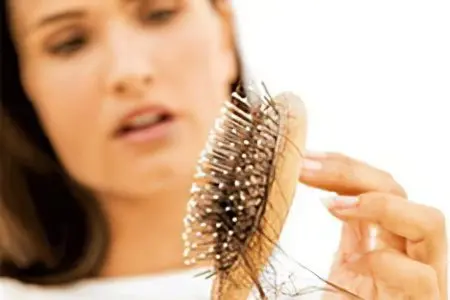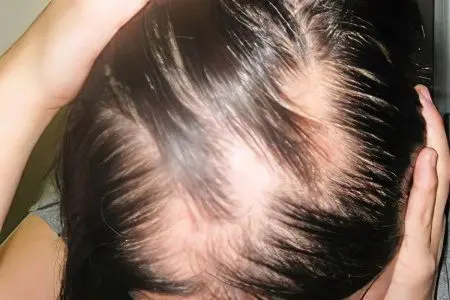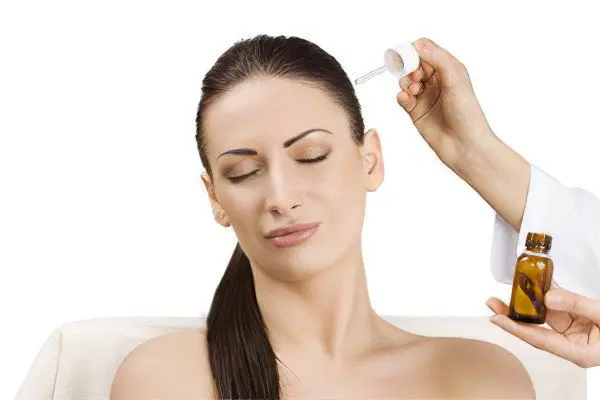Contents
Alopecia in women It is a pathologically caused hair loss. The disease leads either to partial thinning of the hairline, or to its complete disappearance in some areas of the head and body. There are several types of baldness in women – it is focal (alveolar), diffuse (symptomatic) and androgenetic alopecia.
According to available statistics, a third of the entire female population faces the problem of baldness. The age at which alopecia manifests varies from 25 to 45 years, but most often the hair begins to fall out after 40 years. However, baldness can start much earlier.
To diagnose the pathology and determine the methods of treatment, it is necessary to visit a dermatologist, whose narrower specialization is trichology.
Causes of baldness in women

There are many reasons that can trigger the process of baldness in women.
Among the most common are the following:
Polycystic ovary syndrome. Hair falls out as a result of insufficient production of estrogen, while testosterone begins to prevail, which is uncharacteristic for a woman’s body;
Iron-deficiency anemia. Often the lack of hemoglobin and red blood cells is caused by amenorrhea, adherence to strict diets, excessive physical exertion. As a result, both the appearance of a woman in general and the condition of her hair in particular suffer;
The period of pregnancy and lactation. Firstly, most of the nutrients that enter the body of a woman are not spent on her, but on the fetus. Secondly, there is a serious hormonal restructuring. Thirdly, the woman suffers from overwork and chronic fatigue. All these three factors negatively affect the condition of the hair, as a result of which they begin to fall out;
Fungal lesions of the scalp. The vital activity of pathological fungi often causes nested baldness. A mandatory consultation with a doctor and treatment with antimycotic drugs is required;
Pathological disorders of the functioning of the thyroid gland. First of all, hypothyroidism leads to alopecia;
Frequent stress, disorders of the nervous system, all this causes a violation of the blood supply to the scalp and leads to alopecia;
Chronic diseases. Any long-term illness leads to a deterioration in the condition of the hair. In this regard, systemic pathologies, for example, lupus erythematosus and rheumatoid arthritis, infections – pneumonia and tuberculosis, syphilis, poisoning, negatively affect;
Taking certain medicines. There are many drugs that have a negative effect on hair, in particular, these are hormonal contraceptives, antidepressants, laxatives, aspirin, drugs for the treatment of cancer, weight loss agents, etc.;
Injuries and cosmetic procedures. Any injury to the scalp and hair follicles: tension, coloring, bleaching, blow-drying, weaving African braids and other manipulations, has a negative impact. With regular chemical, thermal and traumatic exposure, a woman will definitely begin to lose hair;
Hypothermia of the scalp, which leads to vasospasm;
Regular intake of high doses of caffeine, nicotine, alcohol;
Damage to the scalp by bacteria or parasites, burns, radiation exposure – all this can lead to scarring alopecia. In this case, the bulb is destroyed, the hair stops growing forever;
Chronic telogen hair loss is baldness, the causes of which cannot be established;
Lack of zinc and other essential micro and macro elements in the body.
Stages of hair loss in women
To determine the stage of baldness in the fair sex, the Ludwig scale is used. According to it, it is customary to distinguish three stages of alopecia. The disease begins with the thinning of the hair shafts in the area of the existing parting. Then the baldness spreads in all directions.
So, it is customary to distinguish the following stages of alopecia in women:
The first stage is characterized by a thinning of the hairline in the forehead and in the parietal zone;
The second stage is described as moderate hair loss in the parietal and frontal zone;
In the third stage, there is a pronounced thinning of the hair at the crown. On the sides, the hair remains, but becomes much rarer and thinner.
Types of hair loss in women
All available models of baldness in a woman are represented by several main types: alopecia areata, androgenic, diffuse and alopecia areata.
Alopecia areata

Alopecia areata is a local hair loss with the formation of lesions of a round or oval shape. This process develops as a result of the fact that immune defense cells begin to affect the hair roots. There may be several foci of baldness, but most often it is one.
It is customary to distinguish:
Focal;
multifocal;
subtotal;
Total;
Alopecia areata universalis.
In the last stage of the disease, hair will be lost all over the body. Often in parallel, damage to the nail plates occurs. The disease develops against the background of a genetic predisposition, under the influence of a number of provocative factors. These can be poisoning, stress, the introduction of vaccines, viral diseases, taking antibiotics, etc.
Androgenic alopecia
It is generally accepted that this type of hair loss occurs infrequently in women, although statistics differ. There is evidence that androgenetic alopecia affects women ranging from 20 to 90% of the population. At the same time, a significant excess of testosterone levels is found in the blood of patients. In parallel, a woman suffers from the formation of secondary sexual characteristics characteristic of men. Her facial hair begins to grow, her voice grows rougher. It is not testosterone itself that causes the loss process, but its transformed form – dihydrotestosterone. It appears in the body under the action of the enzyme 5-alpha reductase.
Baldness can begin both with the formation of a strip, and in a nested type. The growth of the alopecia zone occurs unevenly, while the hair falls out completely, resulting in an extensive area with smooth skin. Hair may grow on the top of the head, but they are single processes.
It is generally accepted that this type of baldness is inherited and in 75% of cases it is inherited through the maternal line.
Diffuse alopecia
Diffuse alopecia is hair loss associated with a pronounced sensitivity of hair follicles to such a male hormone as dihydrotestosterone. This is what becomes the main cause of diffuse alopecia in women in 95% of cases.
The clinical picture can develop according to three models:
Alopecia in the form of a strip, also called I-shaped alopecia. In this case, the hair falls out all over the head, and an oblong area is formed in the parietal region, on which the skin is clearly visible. In parallel, hair falls out in the temples and bangs. In the absence of treatment, the band expands and captures the entire parietal zone. The visible area of the scalp is getting larger;
Alopecia by nested type, or O-shaped alopecia;
Androgenetic female pattern baldness, which is considered the most dangerous and can quickly lead to complete hair loss.
As a rule, it is not difficult for a trichologist to diagnose a diffuse type of alopecia. If the disease is ignored, then in the end all strong hair will be lost, and only thin rare rods will remain on the head. A similar condition in trichologists is called the dandelion effect.
Diffuse alopecia can be telogen and anagen. Telogenetic alopecia is most often provoked by nervous stress, hormonal disruptions, medication, surgical interventions, chronic pathologies, adherence to a strict diet. With this form of diffuse alopecia, the follicles go into a resting phase ahead of time.
Anagen diffuse alopecia occurs as a result of exposure to the body of radiation, chemotherapy or strong poisons. That is, the factor that caused baldness was fast and destructive, so the hair follicles did not have time to go into the resting phase, as a result, the hair died and fell out.
Most often, diffuse alopecia disappears after the elimination of the causes that provoked it. After a maximum of 9 months, the hair begins to grow back. Medications such as Minoxidil, sprays, medicated shampoos and hair masks can be used to speed up their growth.
Alopecia areata
This type of diffuse alopecia is characterized by rapid loss of hair follicles. The manifestation of the pathological process is the formation of a strip in the parting area. Gradually, it increases, becoming wider. As a result, a round area of baldness appears on the head, framed on the sides by hair. From above, the head resembles a nest, which gave the name to this form of alopecia.
How to stop hair loss in women?
Treatment for alopecia depends on the underlying cause. Therefore, the first step in the fight against hair loss should be a visit to the doctor. It is he who, on the basis of the diagnostic measures taken, will determine the form of alopecia and outline a therapy plan.
Possible methods of combating baldness caused by pathologies of organs or systems are reduced to:
Therapy of fungal infections of the scalp with antimycotic agents;
Getting rid of iron deficiency anemia with iron preparations and vitamin therapy;
Elimination of endocrine pathologies;
Correction of immune deficiency;
Getting rid of skin diseases;
Solving neurological problems.
If a woman has androgenetic alopecia, then she is shown undergoing treatment using Minoxidil. Other methods of dealing with this genetic disease are ineffective. It should be understood that after the cessation of therapy, the hair will most likely be lost again if we are talking about true alopecia, and not about hair loss due to a disease of other organs.
Hair loss shampoos for women

One of the means of combating hair loss is the use of various shampoos. However, not every popular remedy really has a therapeutic effect, and they need to be used correctly.
It is possible to use the drug with the thymus extract included in its composition as a prophylaxis. This component helps fight dihydrotestosterone, which contributes to hair loss. But the fight against baldness cannot be quick. Two to three weeks is not enough to see the effect. Shampoo will need to be applied for a long time, and the first result can be seen no earlier than in a couple of months. In addition, this drug may not work for some women.
Medicated shampoos are available without a prescription, you can find separate products for men and women. They are produced under different brands and brands. It is desirable that the composition includes nutrients that could stimulate and improve the functioning of hair follicles. It is better to give preference to well-known manufacturers.
In addition to useful components, components harmful to hair can also be found in shampoos. For example, surfactants are dangerous, as they have an aggressive effect on hair follicles. In shampoo formulations, they may be referred to as “sodium lauryl sulfate” or “SLS”. Therefore, if the surfactant is part of the shampoo, it should be discarded.
In case of baldness, as a prophylactic, you can use shampoos based on natural ingredients, for example, with lavender oil, palmette herb or tea tree oil. In any case, before giving preference to one or another remedy, you should consult a doctor.
Perhaps one of the following shampoos will be an excellent way to prevent hair loss:
Progain is a fairly popular drug for alopecia produced by Rogain. This shampoo contains Minoxidil;
Shampoo and oral tablets Provillus. The composition of this complex prophylactic agent includes palmette extract, zinc and magnesium, biotin and Minoxidil, which has a therapeutic effect in androgenetic alopecia;
A three-component alopecia prevention and treatment regimen can be based on the use of Nioxin hair loss products. This is a conditioner, shampoo and directly medical preparation. The shampoo and conditioner are formulated with vitamins, proteins and amino acids to nourish and thicken hair. The drug itself has a depressing effect on the production of dihydrotestosterone. You can choose the most suitable option, based on the condition of the hair, the degree of damage and thinning;
Shampoo Nizoral is an effective remedy for fighting fungal skin lesions. It has a wide spectrum of action and effectively allows you to get rid of dandruff. There is evidence that Nizoral allows you to fight androgenic baldness, but it must be used on an ongoing basis;
Shampoo with its constituent dihydrotestosterone blockers – Revivogen. The active ingredients are metol, saw palmetto and soy protein. This tool can be used both independently and in combination with other preventive and therapeutic shampoos.
Some shampoos work best when combined with other products. So, Nizoral can be used in combination with Rogain. As for taking ketoconazole orally, doctors do not recommend doing this, despite the pronounced inhibitory effect of the drug on androgens and dihydrotestosterone. The risk of developing severe side effects is too high, as this remedy is toxic.
The best shampoo for hair restoration and growth
Many hairdressers recommend that their clients complaining of baldness try using a shampoo that is sold in veterinary shops. This is Zoo Vip shampoo and balm in one bottle. It contains tar and propolis, which allow you to improve hair, stimulate their growth.
While using this product, you can feel an unpleasant odor, but you should not worry about this, it quickly disappears. The agent should not be applied undiluted. Its concentration should be 1 to 10 with a regular shampoo for daily use. After the shampoo is applied to the hair, it should be kept for 7 minutes, and then rinsed with water. To facilitate combing, you can apply any balm or rinse. If severe hair loss is observed, this shampoo should be used on a regular basis. Most of the reviews after using it are positive. In addition, the price of this shampoo is not high at all.
Medicines for the treatment of baldness in women

There are many remedies for the treatment of alopecia in women, but it is impossible to say with certainty that at least one of them will help 100%. According to statistics, the most effective drugs are Minoxidil and Finasteride.
Minoxidil is a liquid remedy that must be applied to the affected areas of the head. Perform the procedure twice a day, which helps stimulate the hair follicles. As a result, hair growth resumes, the shaft itself becomes thicker and remains viable longer. Male representatives can use the product at a concentration of 5%, and women are not recommended to apply Minoxidil in more than a 2% solution. This limitation is explained by the fact that women have an increased risk of facial hair.
The mechanism of operation of the tool remains unclear until the end. However, it is believed that after its application, blood flow to the dormant follicles increases, as it were, it awakens them, and the hair begins to grow again. However, the remedy was originally created to lower blood pressure. Increased hair growth was considered a side effect of taking Minoxidil.
Finasteride is an oral drug. It is released with a prescription. The main action of Finasteride is the inhibition of the production of dihydrotestosterone, which contributes to hair loss in the form of androgenetic alopecia. This drug can be toxic to the fetus if taken by a pregnant woman.
There is evidence that 90% of men stop suffering from hair loss thanks to Finasteride. Moreover, the restoration of hairline is observed in 65% of cases. Of the side effects, a decrease in libido can be noted. When negative effects begin to develop, Finasteride should be discontinued.
Corticosteroids are effective drugs for getting rid of alopecia areata. In this type of alopecia, corticosteroids are given by injection. The first results can be seen after a month. If there are contraindications to injection, then drugs available in the form of creams or ointments can be used. However, the effect will be less pronounced.
There is also a cream for getting rid of baldness, its name is Anthralin. It must be applied to the affected areas every day, after a while the cream is washed off. The tool is effective in relation to the focal type of alopecia. However, a positive result is observed in about a quarter of patients.
Prevention of hair loss in women

Baldness prevention is an important step in the fight against alopecia.
There are some practical tips that can help save your hair:
Hair restoration will occur no earlier than after 6 months. Therefore, it is not necessary to interrupt treatment ahead of time due to the lack of results;
You should lead a healthy lifestyle, give up bad habits, avoid stress;
Hair growth is promoted by B vitamins and zinc;
Sometimes antihistamines can help prevent hair loss. You may want to try switching to a gluten-free diet;
It is necessary to avoid hypothermia of the head so as not to provoke vasospasm. Therefore, in the cold season, you need to wear a hat;
It is recommended to minimize the intake of caffeine;
It is necessary to reduce the traumatic, thermal and chemical effects on the hair.
If baldness proceeds according to the type of androgenetic alopecia, then there are no specific preventive measures, since it is rather problematic to determine the prognosis for the development of pathology. In this regard, it is necessary to contact a trichologist and follow his advice regarding the treatment of a specific form of alopecia.
Author of the article: Herman Olga Leonidovna, trichologist, specially for the site ayzdorov.ru









